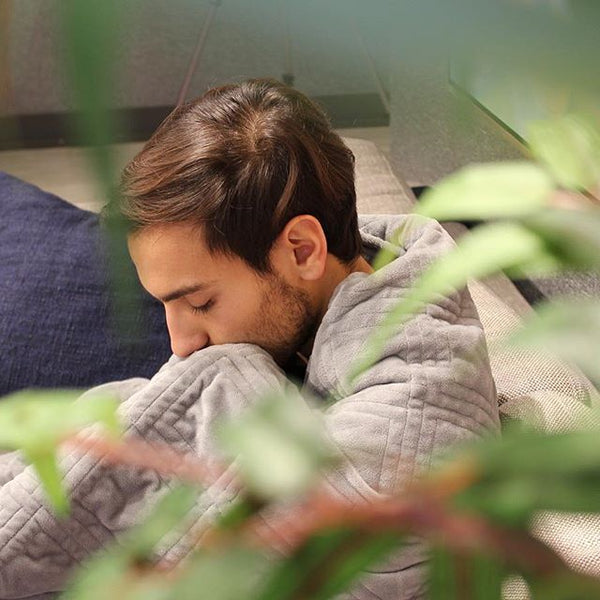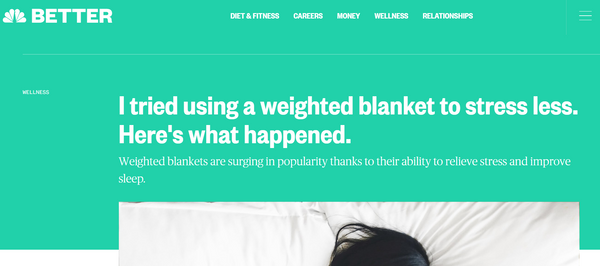If you’re reading this blog post, you probably already have a rough idea of what weighted blankets are about.
In a nutshell, weighted blankets are blankets that are weighed down by stuffers such as plastic pellets, poly pellets or glass beads.
When it comes to how heavy these blankets should be, a general guideline is to choose a blanket that’s 7% to 12% of your body weight. (In our experience, though, you get better results with heavier blankets, so keep that in mind!)
Now, once folks understand the basics of weighted blankets, they often start wondering… what’s the science behind weighted blankets? Do weighted blankets work, for real?
In this article, we seek to demystify weighted blankets, and address all the burning questions that you’ve got about the effectiveness of weighted blankets, once and for all.
Ready? Let’s jump right in!
Do weighted blankets work?
According to multiple studies, yes, weighted blankets do help to alleviate stress and anxiety.
We’ll get to these studies in a bit, but first, let’s explore how weighted blankets work.
Essentially, weighted blankets provide a firm, deep pressure stimulation that’s known as Deep Touch Pressure Therapy (DTP).
If you haven’t heard about DTP before, it’s a form of firm tactile sensory input that provides proprioceptive input to the whole body.
To break it down in simple English, DTP results in a reassuring, cocooning feeling that helps to calm individuals down.
Alright, so now you know the theory behind weighted blankets, let’s talk about exactly how weighted blankets work.
When you drape a weighted blanket across you, this exerts a light, soothing pressure on you, and it produces a “stroking-like” tactile sensation when you move.
As Gaby Badre, M.D., Ph.D., medical director of the sleep disorders clinic (SDS Kliniken) in Gothenburg, Sweden puts it: the tactile stimulation, when amplified by movements, results in the equivalent of a caress.
Now, when we receive this tactile stimulation, this triggers the release of neurotransmitters that act of decrease over-arousal and anxiety.
More specifically, DPT aids in the release of both serotonin and dopamine, which are neurotransmitters that make people feel more relaxed.
How did weighted blankets come about?
Weighted blankets were derived from the Squeeze Machine, which is a therapy tool created by autism researcher, Temple Grandin.
When she was young, Dr. Grandin saw cows being led through a compression device that was designed to hold them in place while administering vaccinations.

While the cows were initially displaying a large amount of anxiety, Dr. Grandin realized that they suddenly become calm and docile upon being squeezed by the machine.
This led to Dr. Grandin coming up with the idea of using DPT to provide comfort to individuals with autism.
Here, Dr. Grandin -- who was on the autism spectrum herself -- drew from her own experiences. She knew that being held and hugged comforted her, but also noted that at times, she felt irritated or alarmed when someone approached her and attempted to hug her.
Bearing this in mind, Dr. Grandin set out to create a device that could help individuals with autism and sensory processing disorders get the positive benefits of a hug without feeling confined or cornered.
After a good deal of trial and error, Dr. Grandin built the Squeeze Machine, which was modelled after the compression machine that she saw on the farm.
This therapy tool applied firm but gentle pressure throughout the patient’s body, and stimulated the release of neurotransmitters in their brain.
Now, while the Squeeze Machine was useful in alleviating stress and anxiety, it was bulky and expensive -- this led manufacturers to come up with the idea of building a lightweight device that could achieve the same benefits.
Enter… the weighted blanket!
While weighted blankets were originally purchased by healthcare professionals, and used as a therapy tool, they’ve grown increasingly mainstream over the past few years.
Today, manufacturers and brands are selling weighted blankets directly to consumers, and it’s no longer seen as a tool specifically for those on the autism spectrum.
Instead, weighted blankets are now commonly used by folks who want to improve their sleep quality and reduce their stress levels!
Why buy a weighted blanket, when you can just give and receive hugs?
If weighted blankets work because of DPT, and DPT can be administered through hugs, then why can’t we simply use hugs to alleviate feelings of stress and anxiety?
First up, individuals who have sensory processing disorders may not always be able to tolerate hugging or even touching. Because these individuals have tactile sensitivity, they get easily overwhelmed by people who touch them or hug them.
Bearing this in mind, if you’ve got an autistic child who’s displaying signs of stress or anxiety, enveloping them in a tight hug may help… but it might also serve to worsen their anxiety.
That’s where weighted blankets come in -- these blankets can apply firm but gentle pressure, and they bring about all the benefits of a hug without forcing any unwelcome or unpleasant body contact.
Autistic individuals aside, how about your average Joe who wants to use DPT to reduce their feelings of stress and anxiety?
For these folks, you can definitely seek out hugs as a form of DPT, but there are certain logistical issues that come into play here.
Assuming you live alone, you probably won’t see your close friends and family EVERY single day -- and this might make it hard for you to get DPT as and when you need it.
Even if you’re living with a partner or close friend, they might not be available to help you ease your stress or anxiety 24/7.

Here’s an example: if you experience chronic insomnia and you don’t fall asleep till the wee hours of the morning, you can’t quite ask your partner to forgo their own sleep to cuddle you till early morning.
The bottom line? Using a weighted blanket is a lot easier, and more realistic!
Weighted blanket therapy: Relevant studies
Still not convinced by weighted blanket therapy?
The following small-scale studies all indicate that weighted blankets do work wonders when it comes to relieving anxiety and reducing insomnia. Read on to find out more!
1) Children with and without ADHD
One of the first studies to address the effectiveness of weighted blankets was published back in 2011 in the Nordic Journal of Psychiatry.
This study involved 42 children aged 8 to 13. Half of the children in the group had been diagnosed with Attention Deficit Hyperactivity Disorder (ADHD), and the other half did not have any medical conditions.
With this study, researchers tracked the children’s sleep via sleep testing for four weeks in total. In the first two weeks, the kids slept how they normally did, and in the last two weeks, they slept using a weighted blanket.
On top of conducting sleep testing, researchers also enlisted the parents’ help in keeping records, in the form of diaries.
All in all, the weighted blankets proved to be profoundly effective for kids with ADHD. More specifically, using weighted blankets reduced the time it took for these children to fall asleep to a level comparable to children without ADHD.
The weighted blankets also reduced the number of middle-of-the-night awakenings in kids with ADHD (again, to a level comparable to children without the condition).
2) Adults with chronic insomnia
Another often-cited study that addresses the effectiveness of weighted blankets was published in 2015 in the Journal of Sleep Medicine and Disorders.
In this study, researchers recruited 31 adults with chronic insomnia, and tracked their quality of sleep across one month.
For the first week, the participants slept using their own bedding. They then spent two weeks sleeping with a weighted blanket, before going back to using their own bedding for the last week.
The results of the study? 80% of the study’s participants indicated that they liked the weighted blanket. These participants reported a range of benefits when using the blanket, including:
- Falling asleep more quickly
- Sleeping for a longer period of time
- Spending less time awake in the middle of the night
- Feeling more refreshed in the morning
3) Patients undergoing wisdom tooth extraction
Finally, the last study we’ll be walking you through today was published in 2016 in the Journal of the Formosan Medical Association; the goal of the study was to observe the effect of weighted blankets on people in stressful circumstances.
This study involved a total of 60 dental patients whom researchers split evenly between an experimental and a control group.
While the experimental group wore a weighted blanket during the wisdom tooth extraction, the control group did not have a blanket on.
After analyzing the results, it was found that the participants who wore a weighted blanket demonstrated “enhanced activity” in the branch of the nervous system that takes over in times of low stress.
In their conclusion, the researchers stated that there was empirical evidence that DPT can influence “autonomic arousal” during stress, mentioning that DPT may be an appropriate therapeutic modality for people in stressful conditions.
Reviews by Business Insider, Healthline, and NBC News
As weighted blankets have gone mainstream, we’ve seen plenty of reputable news outlets review these blankets to provide their own take on whether it works.
In this section, we summarize three reviews by Business Inside, Healthline, and NBC News, so you can form your own opinion on whether weighted blankets are for you!
#1: Business Insider’s weighted blankets review
Blanket tried: 15-pound weighted blanket.
Verdict: Effective.
Reviewer’s notes: “Right away I noticed a huge change in the quality of my sleep.
Each night I get into bed as usual and drape the blanket over the duvet cover and over my body, from my toes to my shoulders. I was falling asleep faster with less tossing and turning to get comfortable and relaxed. I was staying asleep through the night, and I haven't taken any melatonin since making the purchase.”
Link to review: Business Insider
#2: Healthline’s weighted blankets review
Blanket tried: 15-pound weighted blanket, 4 feet wide by 6 feet long.
Verdict: Took a while to get used to, but it was eventually effective.
Reviewer’s notes: “Over the next two weeks, I slept with the weighted blanket each night, and woke up beneath it each morning. I began to feel a beautiful sense of calm when I’d cozy up underneath it before bed. I enjoyed the feeling so much I even began using the blanket when reading before bed or surfing the internet on the couch.”
Link to review: Healthline
#3: NBC News’ weighted blankets review
Blanket tried: 17-pound weighted blanket.
Verdict: Effective.
Reviewer’s notes: “I was able to just focus on the present, and that made it easier to fall asleep. I didn’t wake up once in the middle of the night, which is very rare for me and after 7 hours of solid sleep, I felt so refreshed that I didn’t even need to stop for my iced coffee on the way to office.”
Link to review: NBC News
Want to give weighted blankets a shot?
I hope you got some value out of this summary on weighted blankets and why they work.
If you’re keen on experiencing the magic of weighted blankets with a premium one made just for adults, go ahead and purchase a Hush Blanket for yourself.
Don’t worry about changing your mind -- all Hush Blankets come with an awesome 100 Night Guarantee, and you can get a FULL refund if you decide that the blanket isn’t for you after all.






0 comments